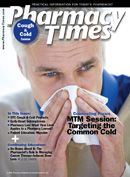Publication
Article
Pharmacy Times
Are We Using Controlled Substances Properly?
Author(s):
Mr. Eckel is professor at the Eshelman School of Pharmacy, University of North Carolina at Chapel Hill.
I recently attended a North Carolina Medicaid Narcotic Task Force meeting. To illustrate the nature of the problems with this patient population, several medication usage studies were presented. One study looked at visits to emergency departments (EDs) to receive narcotics. Over a 1-year period, 37 different patients with ED visits, ranging from 15 to 44, and paid narcotic prescriptions, ranging from 33 to 91, were identified. Another study identified patients who used the ED for dental problems and received narcotic prescriptions. Finally, 1 patient was identified who had received 135 CAT scans within a 2-year period because they were seeking narcotics.
I guess I was so astonished by these studies because I had not realized the lengths some people go to obtain narcotic medication. Further communication made me aware that the misuse of controlled substances is not unique to the Medicaid patient population.
I was aware that narcotic seekers have been going to multiple prescribers and visiting many pharmacies to get narcotic drugs. I also knew that sometimes narcotic-seekers forged prescriptions in an effort to get access to narcotics. In some communities, pharmacies have a “call tree” to alert colleagues to the presence of either behavior in that community.
Identifying Controlled Substance Abusers
Many states like North Carolina have implemented the Controlled Substances Reporting System (CSRS) whose purpose is to “improve the state’s ability to identify controlled substance abusers or misusers and refer them for treatment, and to identify and stop diversion of prescription drugs in an efficient and costeffective manner that will not impede the appropriate medical utilization of licit controlled substances.”
Now the North Carolina CSRS is suggesting that prescribers and community pharmacists access the system before prescribing or dispensing a controlled substance prescription for an unfamiliar patient. In conversations with several prescribers, they have said how helpful this tool has been in identifying drug-seeking behaviors.
I had some concern when this system was proposed, because I remember the effort various health care organizations expended to promote the appropriate dosing of patients with pain. I was concerned that legitimate patients with real pain might not be able to get adequate pain control because prescribers might be reluctant to prescribe an adequate dosage because “big brother” was looking over their shoulder. That problem has not occurred, and some drug-seekers are being identified.
What Should Pharmacists Do?
These recent experiences might suggest that, at best, we are only making small steps in assuring the appropriate use of controlled substances. Here are a few things you might want to think about as you dispense that next controlled substance prescription.
Sometimes the legitimate and appropriate use of a controlled substance can eventually lead to that person becoming addicted. I have heard this story repeated all too often, “I took this product for…pain and eventually I became addicted.” Not an easy subject to discuss with a patient, but we should remain alert to this possibility.
Many states now offer a Recovery Program for impaired pharmacists, an indication that suggests that access to these medications might make it easier for some pharmacy employees to get addicted. Referring a colleague to this program may be the best thing you can do to help them in the long run. Being silent may not be the simple way out as at first it seems.
Because one of pharmacy’s roles is to promote optimal drug therapy, we should be willing to exert leadership in addressing drug abuse, addiction, and related problems. We should celebrate our many colleagues who have done this already.
Take the time to understand the many facets of the controlled substance problem. The problem is complex and does not lend itself to simple solutions. Prejudices and biases often get in the way of our understanding. We should be characterized by compassion, empathy, and support and not be condescending or critical.
At that committee meeting I mentioned, after listening to the efforts some people went to get narcotic drugs, I asked the question, “Why don’t we just give them what they want?” Although I asked it rhetorically, it does suggest that perhaps we need to take a different approach. Are we using controlled substances properly? I will leave you to ponder that question for yourself.







